Occupational Health Management Plan for Atlas Iron Limited
VerifiedAdded on 2023/06/11
|11
|2663
|271
AI Summary
This management plan focuses on iron ore dust as an occupation hazard in Port Hedland. The plan highlights the control measures that are currently in place to control iron dust then develops a health program to improve long term control of iron ore dust.
Contribute Materials
Your contribution can guide someone’s learning journey. Share your
documents today.
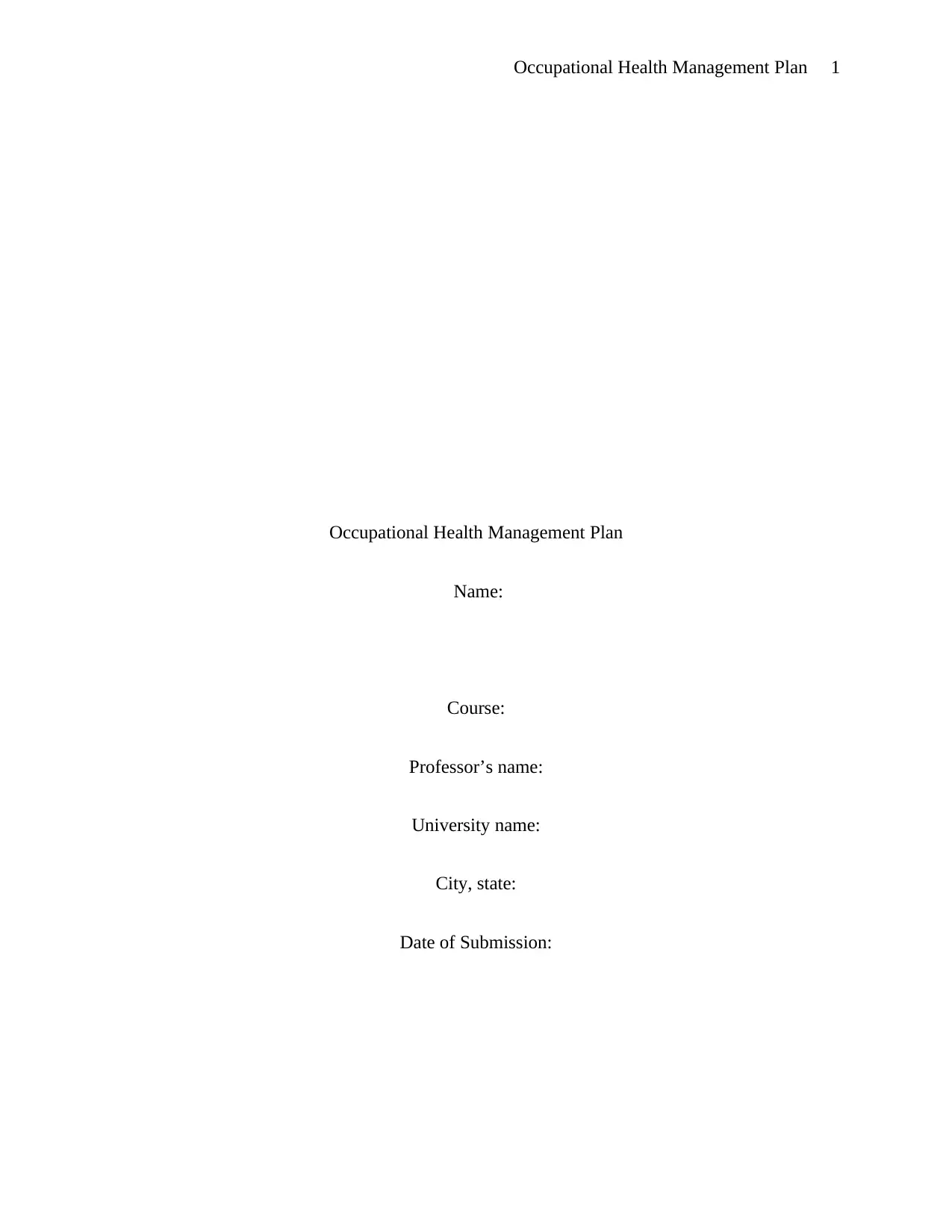
Occupational Health Management Plan 1
Occupational Health Management Plan
Name:
Course:
Professor’s name:
University name:
City, state:
Date of Submission:
Occupational Health Management Plan
Name:
Course:
Professor’s name:
University name:
City, state:
Date of Submission:
Secure Best Marks with AI Grader
Need help grading? Try our AI Grader for instant feedback on your assignments.
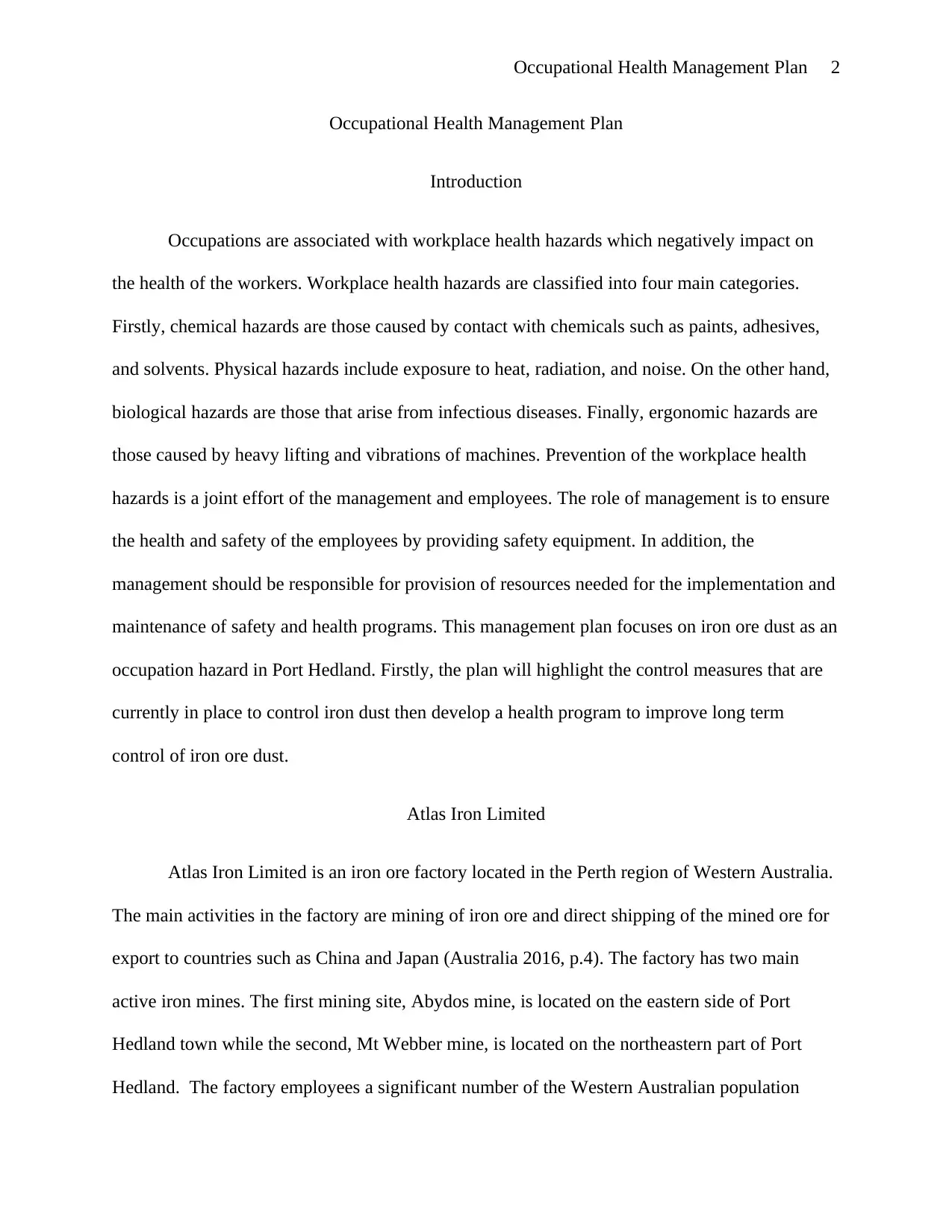
Occupational Health Management Plan 2
Occupational Health Management Plan
Introduction
Occupations are associated with workplace health hazards which negatively impact on
the health of the workers. Workplace health hazards are classified into four main categories.
Firstly, chemical hazards are those caused by contact with chemicals such as paints, adhesives,
and solvents. Physical hazards include exposure to heat, radiation, and noise. On the other hand,
biological hazards are those that arise from infectious diseases. Finally, ergonomic hazards are
those caused by heavy lifting and vibrations of machines. Prevention of the workplace health
hazards is a joint effort of the management and employees. The role of management is to ensure
the health and safety of the employees by providing safety equipment. In addition, the
management should be responsible for provision of resources needed for the implementation and
maintenance of safety and health programs. This management plan focuses on iron ore dust as an
occupation hazard in Port Hedland. Firstly, the plan will highlight the control measures that are
currently in place to control iron dust then develop a health program to improve long term
control of iron ore dust.
Atlas Iron Limited
Atlas Iron Limited is an iron ore factory located in the Perth region of Western Australia.
The main activities in the factory are mining of iron ore and direct shipping of the mined ore for
export to countries such as China and Japan (Australia 2016, p.4). The factory has two main
active iron mines. The first mining site, Abydos mine, is located on the eastern side of Port
Hedland town while the second, Mt Webber mine, is located on the northeastern part of Port
Hedland. The factory employees a significant number of the Western Australian population
Occupational Health Management Plan
Introduction
Occupations are associated with workplace health hazards which negatively impact on
the health of the workers. Workplace health hazards are classified into four main categories.
Firstly, chemical hazards are those caused by contact with chemicals such as paints, adhesives,
and solvents. Physical hazards include exposure to heat, radiation, and noise. On the other hand,
biological hazards are those that arise from infectious diseases. Finally, ergonomic hazards are
those caused by heavy lifting and vibrations of machines. Prevention of the workplace health
hazards is a joint effort of the management and employees. The role of management is to ensure
the health and safety of the employees by providing safety equipment. In addition, the
management should be responsible for provision of resources needed for the implementation and
maintenance of safety and health programs. This management plan focuses on iron ore dust as an
occupation hazard in Port Hedland. Firstly, the plan will highlight the control measures that are
currently in place to control iron dust then develop a health program to improve long term
control of iron ore dust.
Atlas Iron Limited
Atlas Iron Limited is an iron ore factory located in the Perth region of Western Australia.
The main activities in the factory are mining of iron ore and direct shipping of the mined ore for
export to countries such as China and Japan (Australia 2016, p.4). The factory has two main
active iron mines. The first mining site, Abydos mine, is located on the eastern side of Port
Hedland town while the second, Mt Webber mine, is located on the northeastern part of Port
Hedland. The factory employees a significant number of the Western Australian population
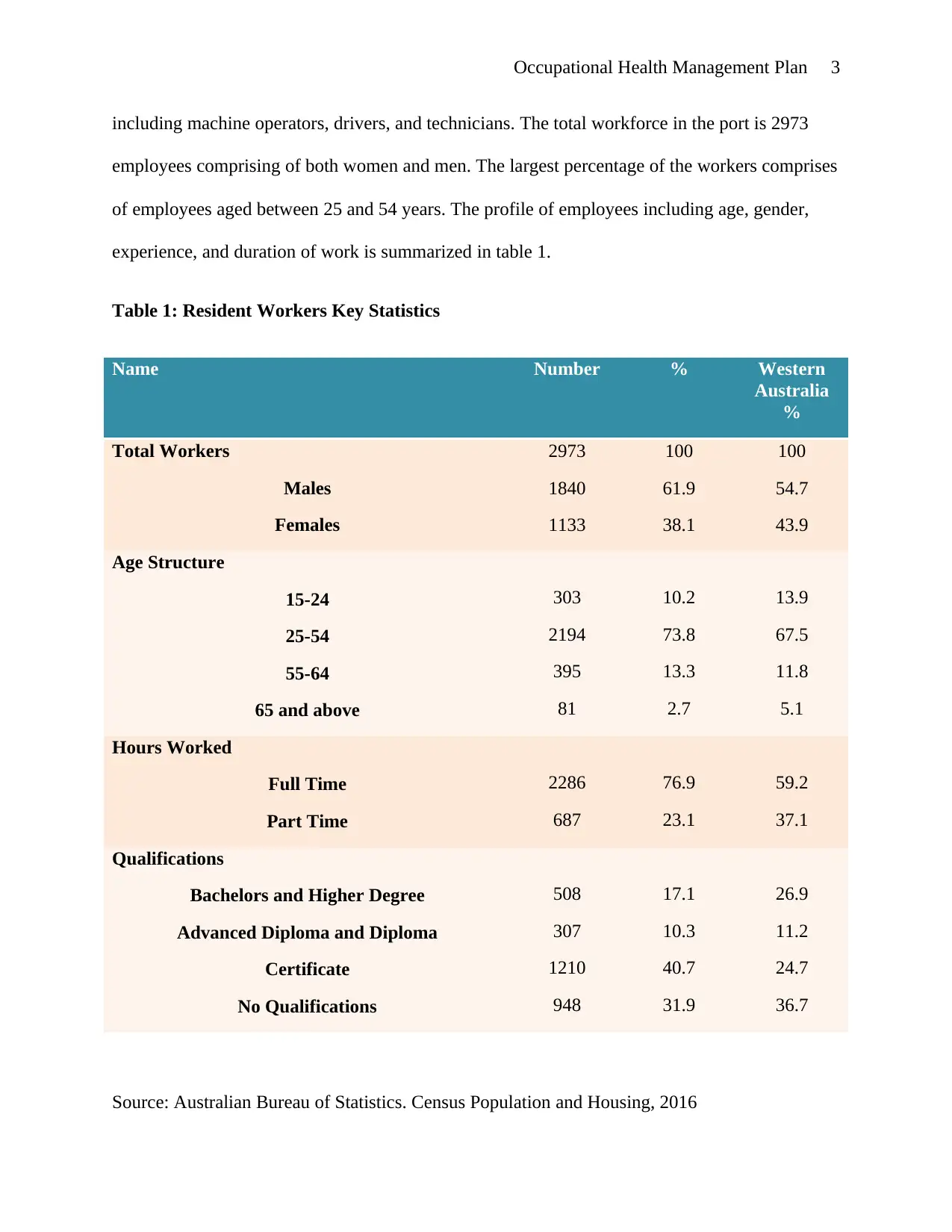
Occupational Health Management Plan 3
including machine operators, drivers, and technicians. The total workforce in the port is 2973
employees comprising of both women and men. The largest percentage of the workers comprises
of employees aged between 25 and 54 years. The profile of employees including age, gender,
experience, and duration of work is summarized in table 1.
Table 1: Resident Workers Key Statistics
Name Number % Western
Australia
%
Total Workers
Males
Females
2973
1840
1133
100
61.9
38.1
100
54.7
43.9
Age Structure
15-24
25-54
55-64
65 and above
303
2194
395
81
10.2
73.8
13.3
2.7
13.9
67.5
11.8
5.1
Hours Worked
Full Time
Part Time
2286
687
76.9
23.1
59.2
37.1
Qualifications
Bachelors and Higher Degree
Advanced Diploma and Diploma
Certificate
No Qualifications
508
307
1210
948
17.1
10.3
40.7
31.9
26.9
11.2
24.7
36.7
Source: Australian Bureau of Statistics. Census Population and Housing, 2016
including machine operators, drivers, and technicians. The total workforce in the port is 2973
employees comprising of both women and men. The largest percentage of the workers comprises
of employees aged between 25 and 54 years. The profile of employees including age, gender,
experience, and duration of work is summarized in table 1.
Table 1: Resident Workers Key Statistics
Name Number % Western
Australia
%
Total Workers
Males
Females
2973
1840
1133
100
61.9
38.1
100
54.7
43.9
Age Structure
15-24
25-54
55-64
65 and above
303
2194
395
81
10.2
73.8
13.3
2.7
13.9
67.5
11.8
5.1
Hours Worked
Full Time
Part Time
2286
687
76.9
23.1
59.2
37.1
Qualifications
Bachelors and Higher Degree
Advanced Diploma and Diploma
Certificate
No Qualifications
508
307
1210
948
17.1
10.3
40.7
31.9
26.9
11.2
24.7
36.7
Source: Australian Bureau of Statistics. Census Population and Housing, 2016

Occupational Health Management Plan 4
Occupational Health Hazard
Iron ore dust is the main occupational health hazard faced by the employees of Atlas Iron
Limited (Sumi and Thomas 2015, p.77). The toxicological impacts of iron ore dust are attributed
to iron oxide and silica contained in the dust .The two compounds cause instillation and
inflammation of the trachea leading to lung diseases (Banerjee, Wang, and Pisaniello 2016,
p.12). The iron dust poisoning occurs during mining and shipping activities which include
excavation and transportation of iron ore. The principal sources of iron dust include loading and
offloading, crushing, conveyor belts, and stockpile erosion (Environmental Health 2016, p.2).
According to the World Health Organization (2016, p.67), long term exposure to iron ore dust is
a risk factor for cardiovascular and respiratory diseases. In addition, Word Health Organization
stipulates that individuals who are more susceptible to risks of iron ore dust are those with
history of cardiovascular diseases, respiratory conditions such as asthma and COPD, and older
persons aged 65 years and above. Given the profile of the employees highlighted in Table 1, it is
highly likely that these persons constitute the workforce of Atlas Iron Limited.
The health risks associated with exposure to iron ore dust are assessed using Health Risk
Assessment (HRA).The results of this assessment established that exposure to iron ore dust is
associated with premature deaths and cardiovascular diseases (Government of Western Australia
2016, p.2). Moreover, the health risk assessment showed that the number of hospital admissions
associated with respiratory diseases such as bronchitis and pneumonia has significantly
increased. Finally, the cases of emergency admissions for pre-existing cases of asthma have also
increased as a result of exposure to iron ore dust (Chinnery and Griffiths 2016, p.15). The
associated health risks are not a result of lack of legal provisions or ethical considerations. In fact
the Western Australia Occupational Safety and Health Act 2005 (2015, p.227) compel the
Occupational Health Hazard
Iron ore dust is the main occupational health hazard faced by the employees of Atlas Iron
Limited (Sumi and Thomas 2015, p.77). The toxicological impacts of iron ore dust are attributed
to iron oxide and silica contained in the dust .The two compounds cause instillation and
inflammation of the trachea leading to lung diseases (Banerjee, Wang, and Pisaniello 2016,
p.12). The iron dust poisoning occurs during mining and shipping activities which include
excavation and transportation of iron ore. The principal sources of iron dust include loading and
offloading, crushing, conveyor belts, and stockpile erosion (Environmental Health 2016, p.2).
According to the World Health Organization (2016, p.67), long term exposure to iron ore dust is
a risk factor for cardiovascular and respiratory diseases. In addition, Word Health Organization
stipulates that individuals who are more susceptible to risks of iron ore dust are those with
history of cardiovascular diseases, respiratory conditions such as asthma and COPD, and older
persons aged 65 years and above. Given the profile of the employees highlighted in Table 1, it is
highly likely that these persons constitute the workforce of Atlas Iron Limited.
The health risks associated with exposure to iron ore dust are assessed using Health Risk
Assessment (HRA).The results of this assessment established that exposure to iron ore dust is
associated with premature deaths and cardiovascular diseases (Government of Western Australia
2016, p.2). Moreover, the health risk assessment showed that the number of hospital admissions
associated with respiratory diseases such as bronchitis and pneumonia has significantly
increased. Finally, the cases of emergency admissions for pre-existing cases of asthma have also
increased as a result of exposure to iron ore dust (Chinnery and Griffiths 2016, p.15). The
associated health risks are not a result of lack of legal provisions or ethical considerations. In fact
the Western Australia Occupational Safety and Health Act 2005 (2015, p.227) compel the
Secure Best Marks with AI Grader
Need help grading? Try our AI Grader for instant feedback on your assignments.
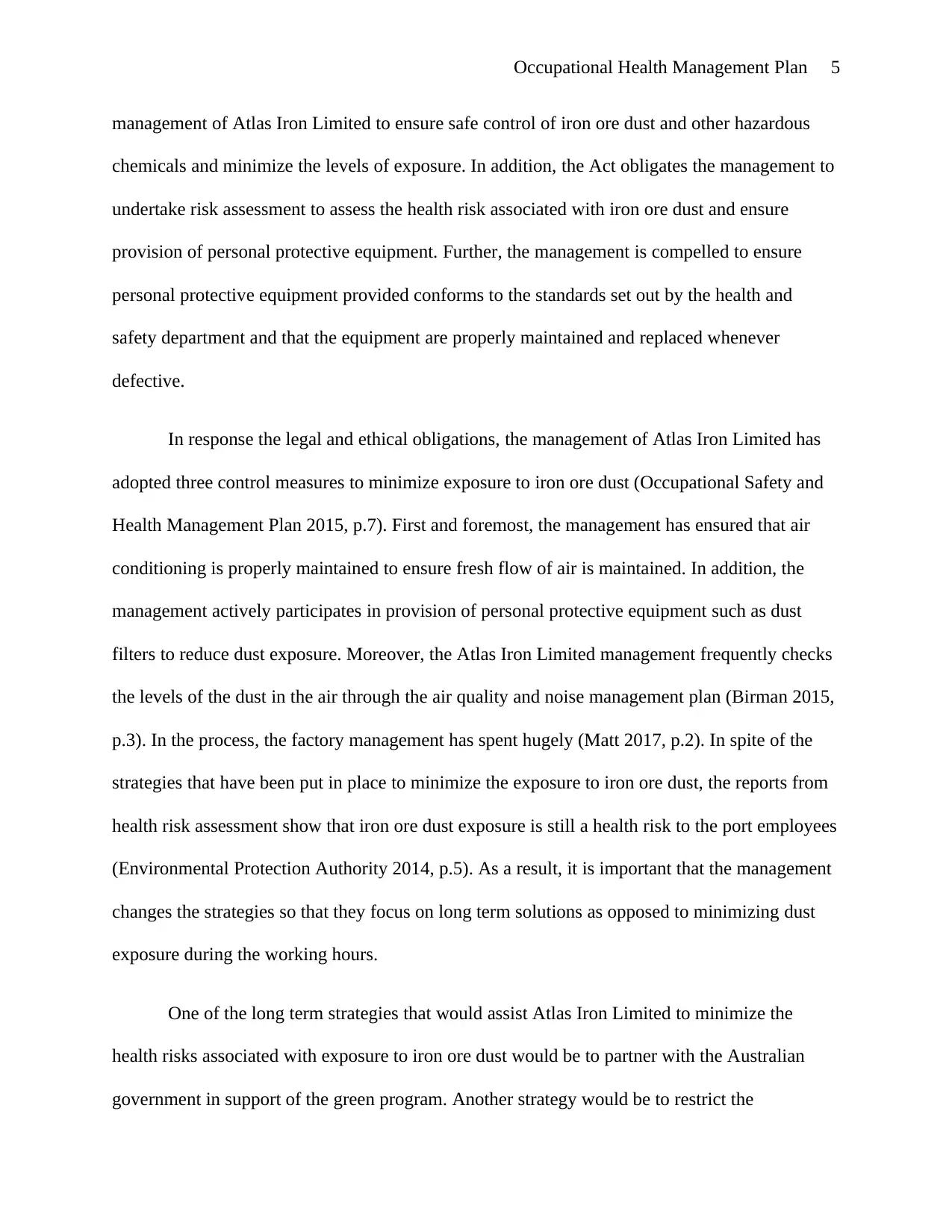
Occupational Health Management Plan 5
management of Atlas Iron Limited to ensure safe control of iron ore dust and other hazardous
chemicals and minimize the levels of exposure. In addition, the Act obligates the management to
undertake risk assessment to assess the health risk associated with iron ore dust and ensure
provision of personal protective equipment. Further, the management is compelled to ensure
personal protective equipment provided conforms to the standards set out by the health and
safety department and that the equipment are properly maintained and replaced whenever
defective.
In response the legal and ethical obligations, the management of Atlas Iron Limited has
adopted three control measures to minimize exposure to iron ore dust (Occupational Safety and
Health Management Plan 2015, p.7). First and foremost, the management has ensured that air
conditioning is properly maintained to ensure fresh flow of air is maintained. In addition, the
management actively participates in provision of personal protective equipment such as dust
filters to reduce dust exposure. Moreover, the Atlas Iron Limited management frequently checks
the levels of the dust in the air through the air quality and noise management plan (Birman 2015,
p.3). In the process, the factory management has spent hugely (Matt 2017, p.2). In spite of the
strategies that have been put in place to minimize the exposure to iron ore dust, the reports from
health risk assessment show that iron ore dust exposure is still a health risk to the port employees
(Environmental Protection Authority 2014, p.5). As a result, it is important that the management
changes the strategies so that they focus on long term solutions as opposed to minimizing dust
exposure during the working hours.
One of the long term strategies that would assist Atlas Iron Limited to minimize the
health risks associated with exposure to iron ore dust would be to partner with the Australian
government in support of the green program. Another strategy would be to restrict the
management of Atlas Iron Limited to ensure safe control of iron ore dust and other hazardous
chemicals and minimize the levels of exposure. In addition, the Act obligates the management to
undertake risk assessment to assess the health risk associated with iron ore dust and ensure
provision of personal protective equipment. Further, the management is compelled to ensure
personal protective equipment provided conforms to the standards set out by the health and
safety department and that the equipment are properly maintained and replaced whenever
defective.
In response the legal and ethical obligations, the management of Atlas Iron Limited has
adopted three control measures to minimize exposure to iron ore dust (Occupational Safety and
Health Management Plan 2015, p.7). First and foremost, the management has ensured that air
conditioning is properly maintained to ensure fresh flow of air is maintained. In addition, the
management actively participates in provision of personal protective equipment such as dust
filters to reduce dust exposure. Moreover, the Atlas Iron Limited management frequently checks
the levels of the dust in the air through the air quality and noise management plan (Birman 2015,
p.3). In the process, the factory management has spent hugely (Matt 2017, p.2). In spite of the
strategies that have been put in place to minimize the exposure to iron ore dust, the reports from
health risk assessment show that iron ore dust exposure is still a health risk to the port employees
(Environmental Protection Authority 2014, p.5). As a result, it is important that the management
changes the strategies so that they focus on long term solutions as opposed to minimizing dust
exposure during the working hours.
One of the long term strategies that would assist Atlas Iron Limited to minimize the
health risks associated with exposure to iron ore dust would be to partner with the Australian
government in support of the green program. Another strategy would be to restrict the
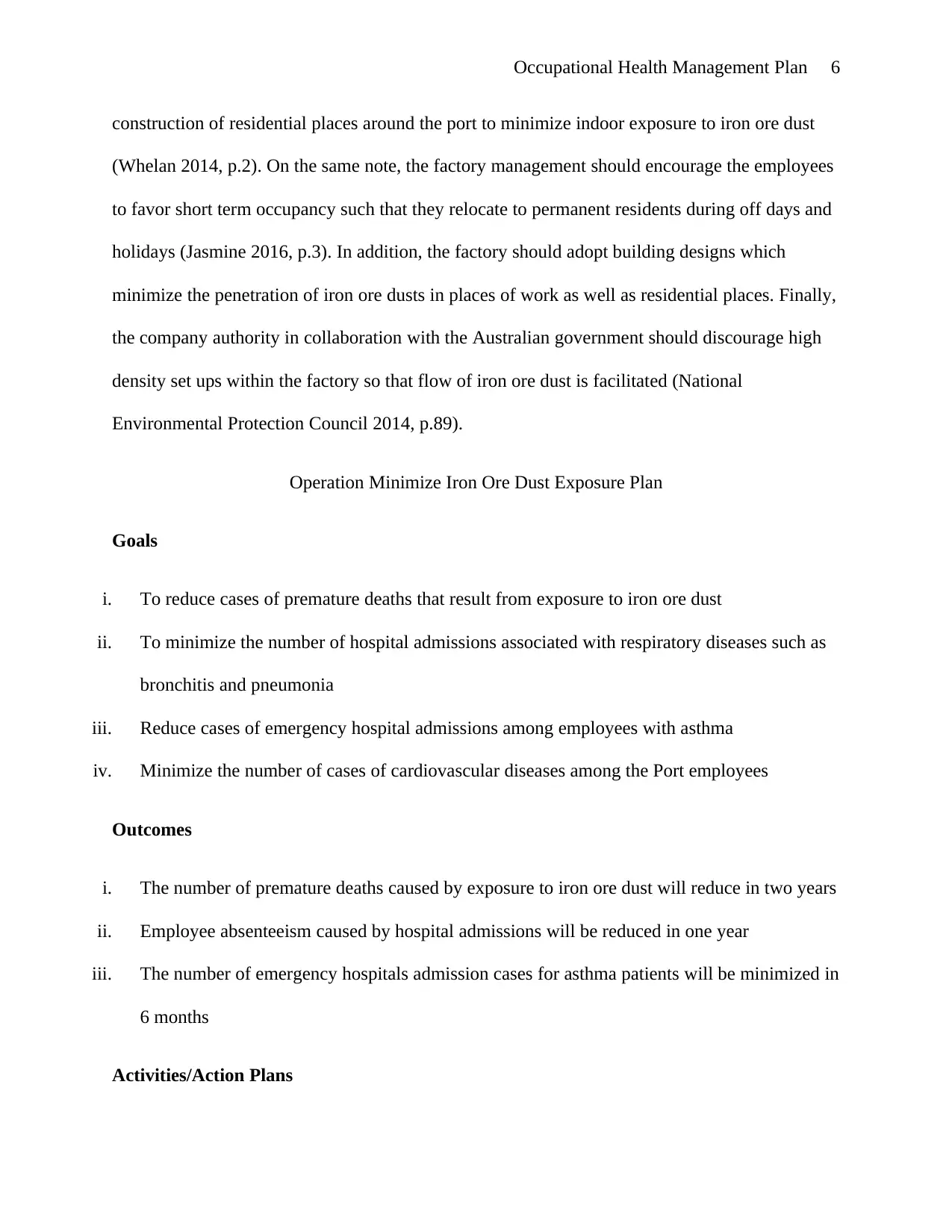
Occupational Health Management Plan 6
construction of residential places around the port to minimize indoor exposure to iron ore dust
(Whelan 2014, p.2). On the same note, the factory management should encourage the employees
to favor short term occupancy such that they relocate to permanent residents during off days and
holidays (Jasmine 2016, p.3). In addition, the factory should adopt building designs which
minimize the penetration of iron ore dusts in places of work as well as residential places. Finally,
the company authority in collaboration with the Australian government should discourage high
density set ups within the factory so that flow of iron ore dust is facilitated (National
Environmental Protection Council 2014, p.89).
Operation Minimize Iron Ore Dust Exposure Plan
Goals
i. To reduce cases of premature deaths that result from exposure to iron ore dust
ii. To minimize the number of hospital admissions associated with respiratory diseases such as
bronchitis and pneumonia
iii. Reduce cases of emergency hospital admissions among employees with asthma
iv. Minimize the number of cases of cardiovascular diseases among the Port employees
Outcomes
i. The number of premature deaths caused by exposure to iron ore dust will reduce in two years
ii. Employee absenteeism caused by hospital admissions will be reduced in one year
iii. The number of emergency hospitals admission cases for asthma patients will be minimized in
6 months
Activities/Action Plans
construction of residential places around the port to minimize indoor exposure to iron ore dust
(Whelan 2014, p.2). On the same note, the factory management should encourage the employees
to favor short term occupancy such that they relocate to permanent residents during off days and
holidays (Jasmine 2016, p.3). In addition, the factory should adopt building designs which
minimize the penetration of iron ore dusts in places of work as well as residential places. Finally,
the company authority in collaboration with the Australian government should discourage high
density set ups within the factory so that flow of iron ore dust is facilitated (National
Environmental Protection Council 2014, p.89).
Operation Minimize Iron Ore Dust Exposure Plan
Goals
i. To reduce cases of premature deaths that result from exposure to iron ore dust
ii. To minimize the number of hospital admissions associated with respiratory diseases such as
bronchitis and pneumonia
iii. Reduce cases of emergency hospital admissions among employees with asthma
iv. Minimize the number of cases of cardiovascular diseases among the Port employees
Outcomes
i. The number of premature deaths caused by exposure to iron ore dust will reduce in two years
ii. Employee absenteeism caused by hospital admissions will be reduced in one year
iii. The number of emergency hospitals admission cases for asthma patients will be minimized in
6 months
Activities/Action Plans
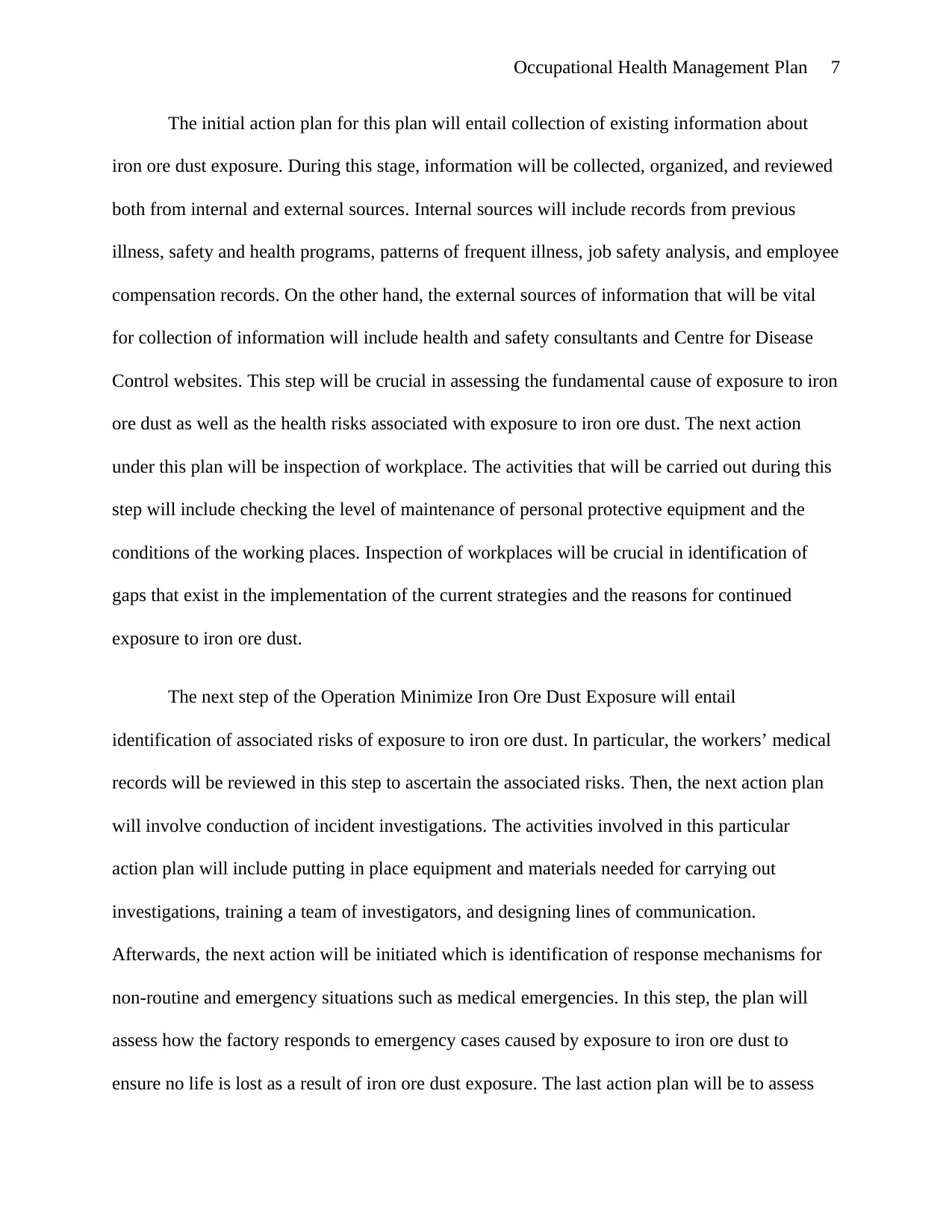
Occupational Health Management Plan 7
The initial action plan for this plan will entail collection of existing information about
iron ore dust exposure. During this stage, information will be collected, organized, and reviewed
both from internal and external sources. Internal sources will include records from previous
illness, safety and health programs, patterns of frequent illness, job safety analysis, and employee
compensation records. On the other hand, the external sources of information that will be vital
for collection of information will include health and safety consultants and Centre for Disease
Control websites. This step will be crucial in assessing the fundamental cause of exposure to iron
ore dust as well as the health risks associated with exposure to iron ore dust. The next action
under this plan will be inspection of workplace. The activities that will be carried out during this
step will include checking the level of maintenance of personal protective equipment and the
conditions of the working places. Inspection of workplaces will be crucial in identification of
gaps that exist in the implementation of the current strategies and the reasons for continued
exposure to iron ore dust.
The next step of the Operation Minimize Iron Ore Dust Exposure will entail
identification of associated risks of exposure to iron ore dust. In particular, the workers’ medical
records will be reviewed in this step to ascertain the associated risks. Then, the next action plan
will involve conduction of incident investigations. The activities involved in this particular
action plan will include putting in place equipment and materials needed for carrying out
investigations, training a team of investigators, and designing lines of communication.
Afterwards, the next action will be initiated which is identification of response mechanisms for
non-routine and emergency situations such as medical emergencies. In this step, the plan will
assess how the factory responds to emergency cases caused by exposure to iron ore dust to
ensure no life is lost as a result of iron ore dust exposure. The last action plan will be to assess
The initial action plan for this plan will entail collection of existing information about
iron ore dust exposure. During this stage, information will be collected, organized, and reviewed
both from internal and external sources. Internal sources will include records from previous
illness, safety and health programs, patterns of frequent illness, job safety analysis, and employee
compensation records. On the other hand, the external sources of information that will be vital
for collection of information will include health and safety consultants and Centre for Disease
Control websites. This step will be crucial in assessing the fundamental cause of exposure to iron
ore dust as well as the health risks associated with exposure to iron ore dust. The next action
under this plan will be inspection of workplace. The activities that will be carried out during this
step will include checking the level of maintenance of personal protective equipment and the
conditions of the working places. Inspection of workplaces will be crucial in identification of
gaps that exist in the implementation of the current strategies and the reasons for continued
exposure to iron ore dust.
The next step of the Operation Minimize Iron Ore Dust Exposure will entail
identification of associated risks of exposure to iron ore dust. In particular, the workers’ medical
records will be reviewed in this step to ascertain the associated risks. Then, the next action plan
will involve conduction of incident investigations. The activities involved in this particular
action plan will include putting in place equipment and materials needed for carrying out
investigations, training a team of investigators, and designing lines of communication.
Afterwards, the next action will be initiated which is identification of response mechanisms for
non-routine and emergency situations such as medical emergencies. In this step, the plan will
assess how the factory responds to emergency cases caused by exposure to iron ore dust to
ensure no life is lost as a result of iron ore dust exposure. The last action plan will be to assess
Paraphrase This Document
Need a fresh take? Get an instant paraphrase of this document with our AI Paraphraser
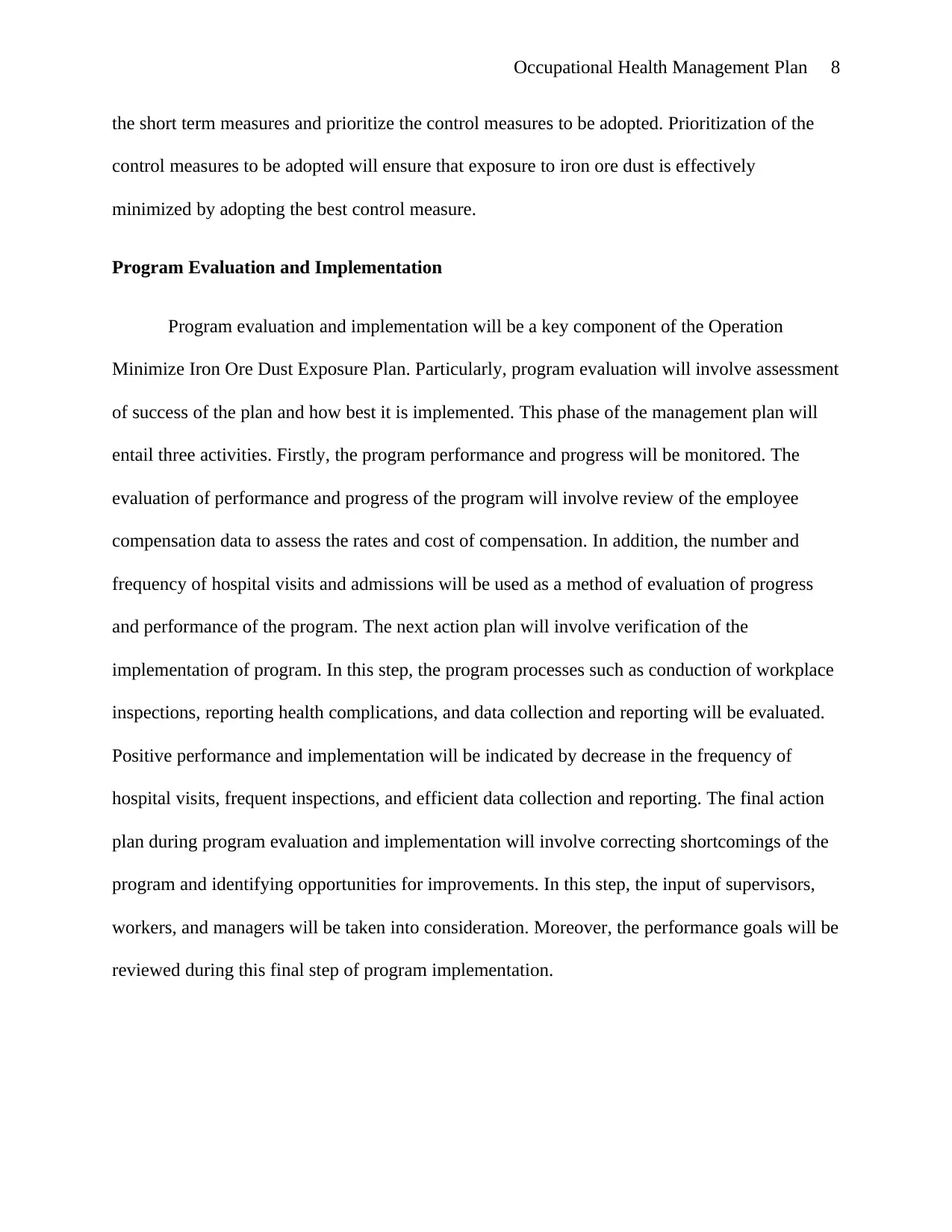
Occupational Health Management Plan 8
the short term measures and prioritize the control measures to be adopted. Prioritization of the
control measures to be adopted will ensure that exposure to iron ore dust is effectively
minimized by adopting the best control measure.
Program Evaluation and Implementation
Program evaluation and implementation will be a key component of the Operation
Minimize Iron Ore Dust Exposure Plan. Particularly, program evaluation will involve assessment
of success of the plan and how best it is implemented. This phase of the management plan will
entail three activities. Firstly, the program performance and progress will be monitored. The
evaluation of performance and progress of the program will involve review of the employee
compensation data to assess the rates and cost of compensation. In addition, the number and
frequency of hospital visits and admissions will be used as a method of evaluation of progress
and performance of the program. The next action plan will involve verification of the
implementation of program. In this step, the program processes such as conduction of workplace
inspections, reporting health complications, and data collection and reporting will be evaluated.
Positive performance and implementation will be indicated by decrease in the frequency of
hospital visits, frequent inspections, and efficient data collection and reporting. The final action
plan during program evaluation and implementation will involve correcting shortcomings of the
program and identifying opportunities for improvements. In this step, the input of supervisors,
workers, and managers will be taken into consideration. Moreover, the performance goals will be
reviewed during this final step of program implementation.
the short term measures and prioritize the control measures to be adopted. Prioritization of the
control measures to be adopted will ensure that exposure to iron ore dust is effectively
minimized by adopting the best control measure.
Program Evaluation and Implementation
Program evaluation and implementation will be a key component of the Operation
Minimize Iron Ore Dust Exposure Plan. Particularly, program evaluation will involve assessment
of success of the plan and how best it is implemented. This phase of the management plan will
entail three activities. Firstly, the program performance and progress will be monitored. The
evaluation of performance and progress of the program will involve review of the employee
compensation data to assess the rates and cost of compensation. In addition, the number and
frequency of hospital visits and admissions will be used as a method of evaluation of progress
and performance of the program. The next action plan will involve verification of the
implementation of program. In this step, the program processes such as conduction of workplace
inspections, reporting health complications, and data collection and reporting will be evaluated.
Positive performance and implementation will be indicated by decrease in the frequency of
hospital visits, frequent inspections, and efficient data collection and reporting. The final action
plan during program evaluation and implementation will involve correcting shortcomings of the
program and identifying opportunities for improvements. In this step, the input of supervisors,
workers, and managers will be taken into consideration. Moreover, the performance goals will be
reviewed during this final step of program implementation.
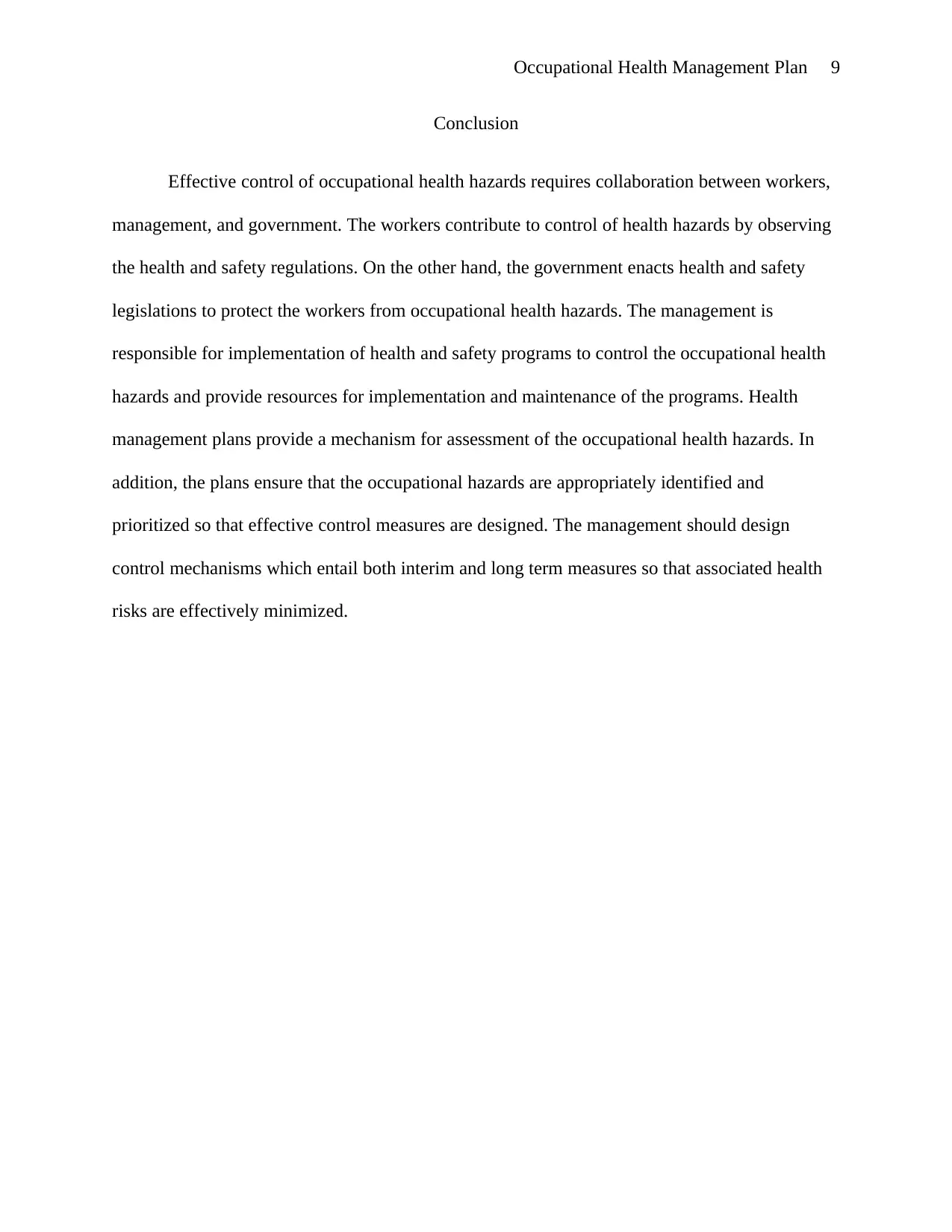
Occupational Health Management Plan 9
Conclusion
Effective control of occupational health hazards requires collaboration between workers,
management, and government. The workers contribute to control of health hazards by observing
the health and safety regulations. On the other hand, the government enacts health and safety
legislations to protect the workers from occupational health hazards. The management is
responsible for implementation of health and safety programs to control the occupational health
hazards and provide resources for implementation and maintenance of the programs. Health
management plans provide a mechanism for assessment of the occupational health hazards. In
addition, the plans ensure that the occupational hazards are appropriately identified and
prioritized so that effective control measures are designed. The management should design
control mechanisms which entail both interim and long term measures so that associated health
risks are effectively minimized.
Conclusion
Effective control of occupational health hazards requires collaboration between workers,
management, and government. The workers contribute to control of health hazards by observing
the health and safety regulations. On the other hand, the government enacts health and safety
legislations to protect the workers from occupational health hazards. The management is
responsible for implementation of health and safety programs to control the occupational health
hazards and provide resources for implementation and maintenance of the programs. Health
management plans provide a mechanism for assessment of the occupational health hazards. In
addition, the plans ensure that the occupational hazards are appropriately identified and
prioritized so that effective control measures are designed. The management should design
control mechanisms which entail both interim and long term measures so that associated health
risks are effectively minimized.
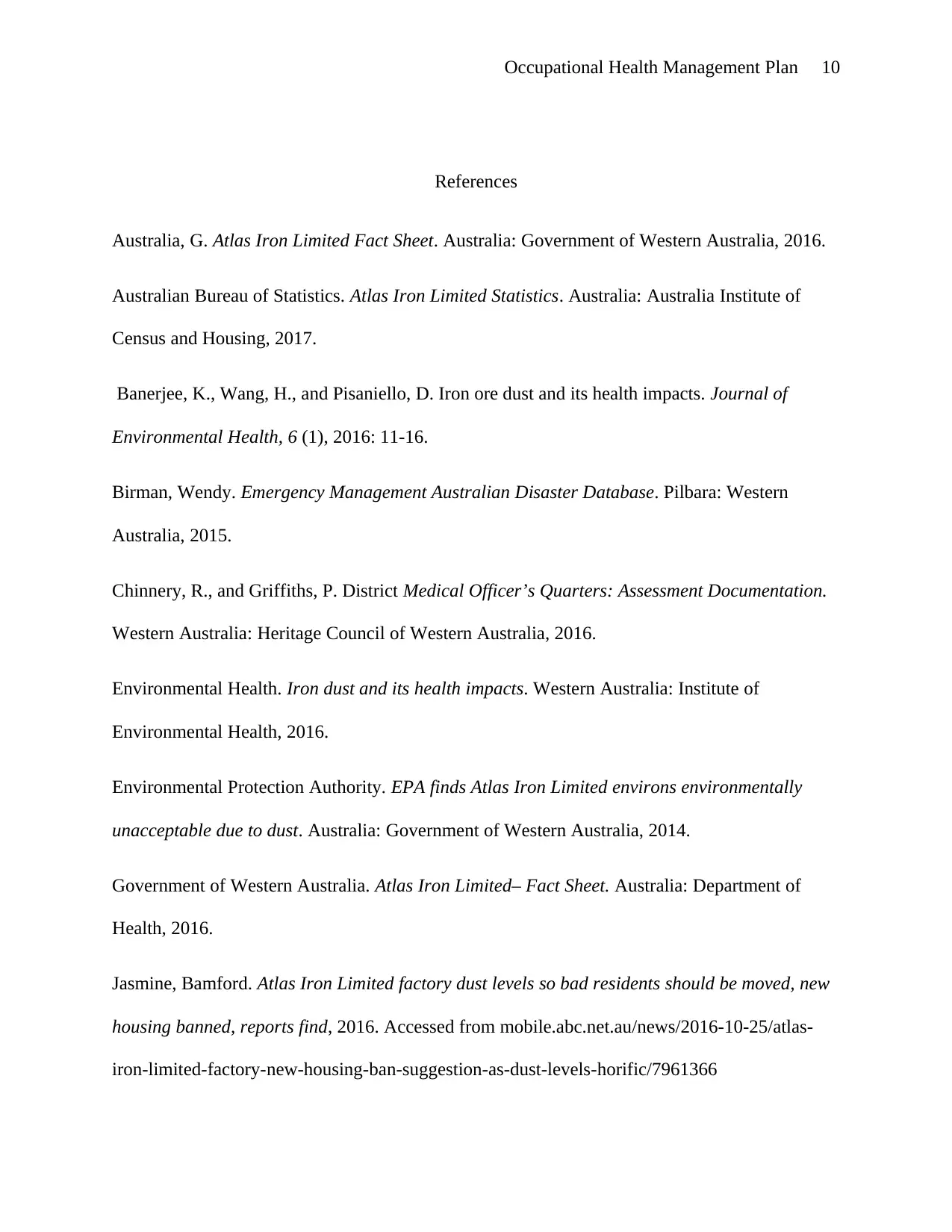
Occupational Health Management Plan 10
References
Australia, G. Atlas Iron Limited Fact Sheet. Australia: Government of Western Australia, 2016.
Australian Bureau of Statistics. Atlas Iron Limited Statistics. Australia: Australia Institute of
Census and Housing, 2017.
Banerjee, K., Wang, H., and Pisaniello, D. Iron ore dust and its health impacts. Journal of
Environmental Health, 6 (1), 2016: 11-16.
Birman, Wendy. Emergency Management Australian Disaster Database. Pilbara: Western
Australia, 2015.
Chinnery, R., and Griffiths, P. District Medical Officer’s Quarters: Assessment Documentation.
Western Australia: Heritage Council of Western Australia, 2016.
Environmental Health. Iron dust and its health impacts. Western Australia: Institute of
Environmental Health, 2016.
Environmental Protection Authority. EPA finds Atlas Iron Limited environs environmentally
unacceptable due to dust. Australia: Government of Western Australia, 2014.
Government of Western Australia. Atlas Iron Limited– Fact Sheet. Australia: Department of
Health, 2016.
Jasmine, Bamford. Atlas Iron Limited factory dust levels so bad residents should be moved, new
housing banned, reports find, 2016. Accessed from mobile.abc.net.au/news/2016-10-25/atlas-
iron-limited-factory-new-housing-ban-suggestion-as-dust-levels-horific/7961366
References
Australia, G. Atlas Iron Limited Fact Sheet. Australia: Government of Western Australia, 2016.
Australian Bureau of Statistics. Atlas Iron Limited Statistics. Australia: Australia Institute of
Census and Housing, 2017.
Banerjee, K., Wang, H., and Pisaniello, D. Iron ore dust and its health impacts. Journal of
Environmental Health, 6 (1), 2016: 11-16.
Birman, Wendy. Emergency Management Australian Disaster Database. Pilbara: Western
Australia, 2015.
Chinnery, R., and Griffiths, P. District Medical Officer’s Quarters: Assessment Documentation.
Western Australia: Heritage Council of Western Australia, 2016.
Environmental Health. Iron dust and its health impacts. Western Australia: Institute of
Environmental Health, 2016.
Environmental Protection Authority. EPA finds Atlas Iron Limited environs environmentally
unacceptable due to dust. Australia: Government of Western Australia, 2014.
Government of Western Australia. Atlas Iron Limited– Fact Sheet. Australia: Department of
Health, 2016.
Jasmine, Bamford. Atlas Iron Limited factory dust levels so bad residents should be moved, new
housing banned, reports find, 2016. Accessed from mobile.abc.net.au/news/2016-10-25/atlas-
iron-limited-factory-new-housing-ban-suggestion-as-dust-levels-horific/7961366
Secure Best Marks with AI Grader
Need help grading? Try our AI Grader for instant feedback on your assignments.

Occupational Health Management Plan 11
Matt, Mckenzie. Atlas Iron Output Continues to fall due to risk of iron ore dust management
expenditure, 2017. Accessed from https://www.businessnews.com.au/article/atlas-iron-output-
continues-to-fall/
National Environmental Protection Council. Atlas Iron Limited Planning Scheme Amendment
56 Statement of Reasons and Advice. Australia: Government of Western Australia, 2014.
Occupational Safety and Health Management Plan. Atlas Iron Limited. Safety and Health
Authority, 2015.
Sumi, L.and Thomas, S. Iron ore mining in Atlas Iron Limited: Issues and Impacts. A
community Primer: Mining Watch Australia, 2015.
Western Australia Occupational Safety and Health Act. Western Australia: Heritage Council of
Western Australia, 2015.
Whelan, R. Iron Dust Levels Reach Peak in Atlas Iron Limited, 2014. Accessed from
http://www.news.com.au.newslimited/iron-dust-levels -reach-peak-in-atlas-iron/
World Health Organization. Risks of Iron Ore Dust to Pilbara Population of Western Australia.
Geneva: World Health Organization, 2016.
Matt, Mckenzie. Atlas Iron Output Continues to fall due to risk of iron ore dust management
expenditure, 2017. Accessed from https://www.businessnews.com.au/article/atlas-iron-output-
continues-to-fall/
National Environmental Protection Council. Atlas Iron Limited Planning Scheme Amendment
56 Statement of Reasons and Advice. Australia: Government of Western Australia, 2014.
Occupational Safety and Health Management Plan. Atlas Iron Limited. Safety and Health
Authority, 2015.
Sumi, L.and Thomas, S. Iron ore mining in Atlas Iron Limited: Issues and Impacts. A
community Primer: Mining Watch Australia, 2015.
Western Australia Occupational Safety and Health Act. Western Australia: Heritage Council of
Western Australia, 2015.
Whelan, R. Iron Dust Levels Reach Peak in Atlas Iron Limited, 2014. Accessed from
http://www.news.com.au.newslimited/iron-dust-levels -reach-peak-in-atlas-iron/
World Health Organization. Risks of Iron Ore Dust to Pilbara Population of Western Australia.
Geneva: World Health Organization, 2016.
1 out of 11
Your All-in-One AI-Powered Toolkit for Academic Success.
+13062052269
info@desklib.com
Available 24*7 on WhatsApp / Email
![[object Object]](/_next/static/media/star-bottom.7253800d.svg)
Unlock your academic potential
© 2024 | Zucol Services PVT LTD | All rights reserved.


